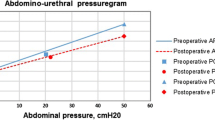Abstract
In 19 patients with different types of severe descensus, all without clinical evidence of stress incontinence, urethral stress pressure profiles and stress tests were done before and after repositioning of the prolapse. In 13 of the 19 patients, continence was artificial, because during repositioning they showed leakage of urine; however, 6 of the patients remained continent. The pressure transmission ratios decreased in different parts of the urethra in all the patients when repositioning with a gynecological speculum was done. The drop was most significant in those patients who lost urine after repositioning, showing poor urethral function. In women with genito-urinary prolapse, a test of urethral function is essential, even if there is no clinical evidence of incontinence after removal of the descensus. In cases of severe stress incontinence under this condition, a procedure for bladder neck stabilization should be added to routine prolapse surgery.
Similar content being viewed by others
References
Calatroni CJ, Poliak A, Kohan A. A roentgenologic study of stress incontinence in women. Am J Obstet Gynecol 1962; 83:649–656
Green TH. Development of a plan for the diagnosis and treatment of urinary stress incontinence. Am J Obstet Gynecol 1962; 83: 632–648
Bergman A, Koonings PP, Ballard CA. Predicting postoperative urinary incontinence development in women undergoing operation for genitourinary prolapse. Am J Obstet Gynecol 1988; 158:1171–1175
Hodgkinson CP. Stress urinary incontinence — 1970. Am J Obstet Gynecol 1970; 108:1141–1168
Arnold EP, Webster JR, Looser H, et al. Urodynamics of female incontinence: factors influencing the results of surgery. Am J Obstet Gynecol 1973; 117:805–813
Bump RC, Copeland WE, Hurt WG, Fantl JA. Dynamic urethral pressure/profilometry pressure transmission ratio determinations in stress incontinence and stress continent subjects. Am J Obstet Gynecol 1988; 159:749–755
Eberhard J. Standardisierte Urethradruckmessung mit Normwerten zur Streßinkontinenzdiagnostik. Geburtsh Frauenheilk 1986; 46: 145–150
Tanagho EA. Urodynamics: cystometry and the urethral closure pressure profile. In: Ostergard DR, ed. Gynecologic urology and urodynamics, Baltimore: Williams and Wilkins, 1980:65–86
Green TH. Urinary stress incontinence: differential diagnosis, pathology, and management. Am J Obstet Gynecol 1975; 122: 368–400
Richardson DA, Bent AE, Ostergard DR. The effect of uterovaginal prolapse on urethrovesical pressure dynamics. Am J Obstet Gynecol. 1983; 146:910–905
Hertogs K, Stanton SL. Mechanism of urinary continence after colposuspension: barrier studies. Br J Obstet Gynaecol 1985; 92: 1184–1188
Iosif CS. Operative treatment of women with prolapse and genuine primary stress incontinence. Urol Int 1983; 38:199–202
Author information
Authors and Affiliations
Rights and permissions
About this article
Cite this article
de Gregorio, G., Hillemanns, H.G. Urethral closure function in women with prolapse. Int Urogynecol J 1, 143–145 (1990). https://doi.org/10.1007/BF00376600
Issue Date:
DOI: https://doi.org/10.1007/BF00376600




